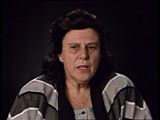You searched for: ust交易程序後臺源碼【tg���������@ek7676】平台包网搭建unit交易程序後臺源碼【tg���������@ek7676】平台包网搭建ivkcss1pgu
<< Previous | Displaying results 1201-1250 of 1755 for "ust交易程序後臺源碼【tg���������@ek7676】平台包网搭建unit交易程序後臺源碼【tg���������@ek7676】平台包网搭建ivkcss1pgu" | Next >>
-
Leah Hammerstein Silverstein describes starvation in the Warsaw ghetto
Oral HistoryLeah grew up in Praga, a suburb of Warsaw, Poland. She was active in the Ha-Shomer ha-Tsa'ir Zionist youth movement. Germany invaded Poland in September 1939. Jews were forced to live in the Warsaw ghetto, which the Germans sealed off in November 1940. In the ghetto, Leah lived with a group of Ha-Shomer ha-Tsa'ir members. In September 1941, she and other members of the youth group escaped from the ghetto to a Ha-Shomer ha-Tsa'ir farm in Zarki, near Czestochowa, Poland. In May 1942, Leah became a courier…
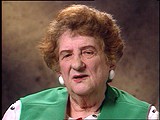
-
Leah Hammerstein Silverstein describes bombings in Praga and Warsaw after the outbreak of World War II
Oral HistoryLeah grew up in Praga, a suburb of Warsaw, Poland. She was active in the Ha-Shomer ha-Tsa'ir Zionist youth movement. Germany invaded Poland in September 1939. Jews were forced to live in the Warsaw ghetto, which the Germans sealed off in November 1940. In the ghetto, Leah lived with a group of Ha-Shomer ha-Tsa'ir members. In September 1941, she and other members of the youth group escaped from the ghetto to a Ha-Shomer ha-Tsa'ir farm in Zarki, near Czestochowa, Poland. In May 1942, Leah became a courier…

-
Leah Hammerstein Silverstein describes the emotions she felt upon arrival in Tel Aviv and Jerusalem after the war
Oral HistoryLeah grew up in Praga, a suburb of Warsaw, Poland. She was active in the Ha-Shomer ha-Tsa'ir Zionist youth movement. Germany invaded Poland in September 1939. Jews were forced to live in the Warsaw ghetto, which the Germans sealed off in November 1940. In the ghetto, Leah lived with a group of Ha-Shomer ha-Tsa'ir members. In September 1941, she and other members of the youth group escaped from the ghetto to a Ha-Shomer ha-Tsa'ir farm in Zarki, near Czestochowa, Poland. In May 1942, Leah became a courier…
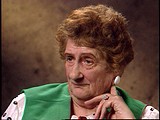
-
Zdziecioł (Zhetel)
ArticleThe Nazis occupied Zdziecioł (Zhetel), Poland in 1941. Learn more about the city and ghetto during World War II.
-
Lublin/Majdanek Concentration Camp: Conditions
ArticleIn 1940, the Nazis established Lublin (Majdanek) concentration camp in Lublin, Poland. Learn more about camp conditions.
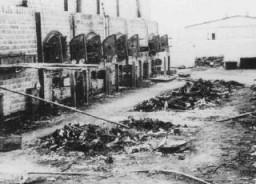
-
Flossenbürg
ArticleLearn about the Flossenbürg camp from its establishment until liberation in April 1945, including conditions, forced labor, subcamps, and death marches.

-
1942: Key Dates
ArticleExplore a timeline of key events during 1942 in the history of Nazi Germany, World War II, and the Holocaust.

-
Belzec
ArticleBelzec was the first of three killing centers in Operation Reinhard, the SS plan to murder almost two million Jews living in the German-administered territory of occupied Poland.

-
Mannschafts-Stammlager (Stalag) IX B
ArticleIn 1939, the Nazis established the Mannschafts-Stammlager (Stalag) IX B camp in Germany. Learn more about the camp’s history, prisoners, and liberation.
-
Mordecai Pinchas Szabasson
ID CardMordecai, known in Yiddish as Motl, was born to a religious Jewish family with six children. His hometown of Kozienice, located near a birch forest, had an important lumber industry. After graduating from secondary school, Mordecai entered the lumber business. His small, successful company bought and sold lumber. 1933-39: A few months after the Germans invaded Poland in September 1939, Mordecai's father was warned to leave because, as a prominent member of the community, it was likely that the Germans…
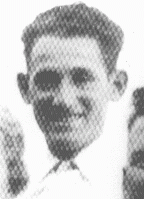
-
Lewek Szabasson
ID CardLewek and his five brothers and sisters were born to religious Jewish parents in the town of Kozienice, situated in east central Poland near a birch forest. Lewek's father owned a sawmill, and when Lewek and his brothers were grown, they helped their father manage the family business. 1933-39: When Lewek was 15 he attended an agricultural school near Kozienice, because he wanted to immigrate to Palestine [Aliyah] to work the land. But after the Nazis rose to power in Germany in 1933, immigration…

-
Israel Milkow
ID CardIsrael was born to a religious Jewish family living in the town of Slonim. He was called Yisroel by his Yiddish-speaking parents. Israel's father, Lazar Milkow, was a baker who supported his family on a meager income. 1937-39: Israel's grandparents and many of his mother's relatives lived in a nearby village called Kaslovchina. Each summer one of the Milkow boys was invited to stay in Kaslovchina with their Uncle Herschel who worked as a farmer and horse trader. In September 1939 Slonim became part of the…
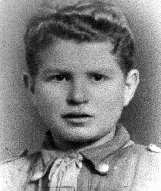
-
Edith Goldman Bielawski
ID CardEdith's parents owned a cotton factory in the town of Wegrow [in Poland]. The Goldmans were a religious family, and raised Edith, her brother and three sisters to strictly observe the Sabbath, Jewish holidays and the dietary laws. 1933-39: Edith attended public school, and also studied at the Beis Yakov religious school for girls where she learned Hebrew, the Bible and Jewish history. Her favorite hobby was knitting, and after finishing secondary school she learned the quilt-making trade. In the…
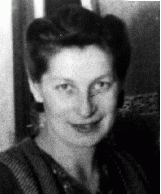
-
Albert Gani
ID CardAlbert and his family lived in Preveza, a town with a Jewish population of 300 that was located on the Ionian seashore. Albert's father had a small textile shop. The Ganis were of Romaniot descent, Jews whose ancestors had lived in Greece and the Balkans for more than a thousand years. 1933-39: After graduating from high school, Albert assisted his father in the family textile shop. A quiet and reserved young man, Albert enjoyed spending time at home with his family. Albert loved taking excursions with…
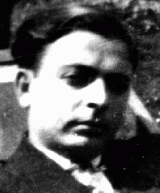
-
Joseph Gani
ID CardJoseph and his family lived in Preveza, a town with a Jewish population of 300 that was located on the Ionian seashore. Joseph's father had a small textile shop. The Ganis were of Romaniot descent, Jews whose ancestors had lived in Greece and the Balkans for more than a thousand years. 1933-39: Joseph attended Greek public school in Preveza. He also received a religious education; the local rabbi would come to the public school for several hours a week to give religious instruction to the Jewish students.…
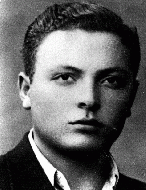
-
Marta Herman
ID CardThe younger of two daughters, Marta was raised by Hungarian-speaking Jewish parents in Kosice, a city in Slovakia. Marta attended a Jewish elementary school. Her father ran a small grocery store. 1933-39: After Marta finished elementary school, she began secondary school. The language of instruction was Slovak and Jews faced no discrimination until November 1938 when Hungarian troops marched into southern Slovakia. With Germany's blessing, Kosice became part of Hungary and was renamed Kassa. Their new…

-
Lisa Dawidowicz
ID CardLisa was born to a Jewish family in the small city of Ostrog in southeastern Poland. Her parents operated a grocery out of their residence; the front half of the house was a store and the rear half was their home. Ostrog was an important center of Jewish religious learning in Poland, and by 1933 Jews made up almost two-thirds of the city's total population. 1933-39: Lisa's family was religious and they regularly attended services. Lisa studied at a Polish school until the Soviets arrived in September…

-
Henry Maslowicz
ID CardHenry's Jewish parents lived in a Polish town in which their families had lived for 150 years. The Jewish community enjoyed good relations with their Polish neighbors; the local Polish population refused to cooperate when the government encouraged a boycott of Jewish businesses during a wave of antisemitism that swept Poland in the mid-1930s. 1933-39: In the years before Henry was born, his father owned an iron and coal factory. The Germans occupied Wierzbnik on September 5, 1939. While some Jews fled,…

-
Shlomo Reich
ID CardShlomo was one of seven children born in Lodz to the Reich family. The Reichs were a religious Jewish family, and Shlomo's Hasidic father wore earlocks and a traditional fur hat. After public school every day, Shlomo attended the Ostrovtze Yeshiva, a rabbinical academy where he studied Jewish holy texts. Shlomo's father owned a shoelace factory. 1933-39: The Germans invaded Lodz in September 1939 and began to institute anti-Jewish measures. Jews were not allowed to use public transportation, to leave the…

-
Benjamin Soep
ID CardBenjamin, called "Benno" by his family and friends, grew up in a religious Jewish household in Amsterdam. Benno's father, a successful diamond manufacturer, was president of the Amsterdam Jewish community. Benno had two younger sisters and enjoyed collecting stamps. 1933-39: After he obtained some work experience in a department store, Benno joined his father in the diamond business. Benno adhered strictly to Jewish law. He loved tennis and skiing, and in 1938, while skiing in Switzerland, he met a girl…
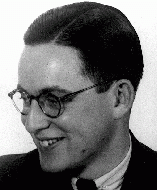
-
Valtr Krakauer
ID CardValtr was the fourth of six children born to Jewish parents in a small Moravian town, where his father ran a dry-goods and clothing store. The Krakauers spoke both Czech and German at home. Valtr attended German-language schools and also played soccer for the Maccabi Jewish team. After graduating from secondary school, Valtr enrolled in a fashion-design school in the city of Brno. 1933-39: In Brno, Valtr founded a factory that produced ready-made clothes. He closely followed the rise of Nazism in Germany…
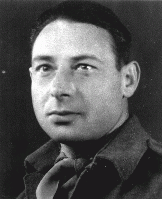
-
Moise Gani
ID CardMoise's family were Romaniot Jews, a group that had lived in Greek cities and the Balkans for 1,100 years. In the early 1920s Moise's family moved to Italy, where his father tried to find work. Moise attended school, and when his family returned to Greece after two years, he remained in Italy to complete school. When Moise returned to Preveza at age 17, he had forgotten Greek. 1933-39: Moise worked as a bookkeeper and administrator at the local electric company in Preveza, and he lived with his parents.…
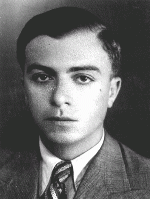
-
League of German Girls jacket
ArtifactThis League of German Girls jacket has two embroidered cloth patches handstitched to the upper left sleeve: a dark triangle displaying the name of the member’s region, South Franconia (Süd Franken), and a Hitler Youth insignia. Beginning in 1933, the Hitler Youth and its organization for girls and young women, the League of German Girls, played an important role in the new Nazi regime. Through these organizations, the Nazi regime indoctrinated young people with Nazi ideology, including antisemitism and…
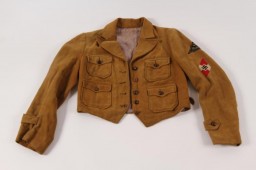
-
David Birnbaum
ID CardDavid, known as Dudek by his family and friends, came from Radom, a city with a large Jewish population. David's family was involved in Zionist activities, and David attended a Jewish religious school every afternoon after returning from public school. His father owned a distillery. 1933-39: The Germans invaded Poland on September 1, 1939, and Radom was occupied on September 8, 1939. The Germans were seizing Jewish men to work as slave laborers, and the Birnbaum family knew that they might spare those who…
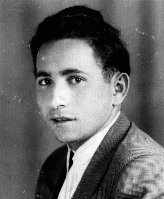
-
Istvan Geroe
ID CardIstvan was born to a Jewish family in the small agricultural city of Torokszentmiklos, about 65 miles from Budapest. Istvan worked for the Hungarian railroads during World War I, and afterwards earned a degree in pharmacology. In the 1920s Istvan married Barbara Nemeth and they settled in Torokszentmiklos. In 1929 the couple had a son, Janos. 1933-39: During the early 1930s, after the onset of the Depression, Istvan helped his father in the family's grain exporting business. In 1933 Istvan and Barbara…

-
Jeno Katz
ID CardOne of eight children, Jeno was born to religious Jewish parents in the northeastern Hungarian town of Buj. The family later moved to the village of Zalkod, where Jeno's father ran a general store. His schooling over, Jeno became a cabinet maker. After he married, he and his wife Eloise settled down in Sarospatak, a picturesque town with a ruined medieval fortress and the Windischgratz castle. 1933-39: Jeno's sister Sadie, who had immigrated to the United States, came to visit her parents in Zalkod. At…
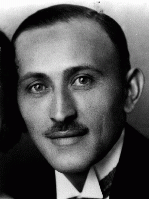
-
Curt Egon Rosenberg
ID CardCurt was the oldest of three children born to a Jewish family in the famous German university city of Goettingen. His father owned a linen factory that had been in the family since it was founded by Curt's grandfather. Goettingen had a small Jewish population, with only one synagogue. Curt attended public school in the city. 1933-39: The Nazis came to power in 1933. A year later, the Rosenbergs' factory was seized and the family was forced to move to Hamburg. Because he was Jewish, Curt was arrested in…
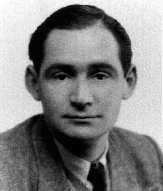
-
Killing Centers: An Overview
ArticleThe Nazis established killing centers in German-occupied Europe during WWII. They built these killing centers for the mass murder of human beings.

-
Pavol Kovac
ID CardAs a boy, Pavol lived with his parents in the city of Martin in Slovakia. His father taught at the local agricultural college. The Kovacs, who were non-practicing Jews, were among the few Jewish residents in the town. 1933-39: When Pavol was born, almost nine months before the outbreak of World War II, his parents decided to have "Roman Catholic" listed under the entry for religion in his birth certificate. They took this step to protect him, despite the fact that for generations Jews in their region had…
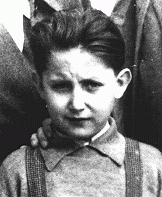
-
Isaac Sandler
ID CardIsaac was one of six children born to a Jewish family in the Ukrainian village of Vachnovka in the Soviet Union. In the mid-1920s, Isaac married, and moved to the Ukrainian capital of Kiev. 1933-39: In Kiev Isaac worked as a house-painter. Because he had married a Christian Ukrainian woman, he was shunned by some of his relatives who believed this union violated Jewish law. Isaac was considered the "black sheep" of his family. 1940-41: When Germany invaded the Soviet Union in June 1941, Isaac was…
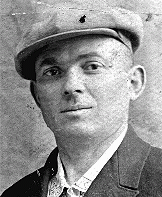
-
Dezider Gruenberger
ID CardDezider was the oldest of three children born to Hungarian-speaking Jewish parents in the city of Kosice in the southeastern part of Czechoslovakia known as Slovakia. As a young boy, he attended a Jewish elementary school. His father was a tailor whose workshop was in the Gruenberger's small apartment. 1933-39: After Dezider finished elementary school, he entered secondary school with a view to going on to the university. The language of instruction was Slovak, and Jews faced no discrimination until…
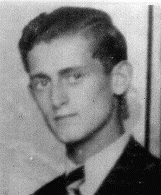
-
Dawid Sierakowiak
ArticleYoung people's diaries capture some of the most heartbreaking experiences of the Holocaust. Learn about the diary and experiences of David Sierakowiak.
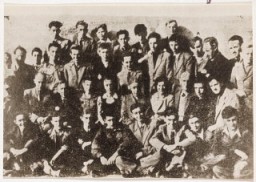
-
Safe conduct pass issued to a prisoner in Djelfa
DocumentSafe conduct pass issued to Hans Landesberg in the Djelfa internment camp, releasing him to leave for Algiers. Djelfa, Algeria, January 26, 1943. Hans was born in Vienna, Austria, and went to medical school. After graduating, he left for Paris and joined a battalion of the International Brigade to fight in the Spanish Civil War. He returned to France in February 1939, only to be interned first in Argeles and then in Gurs. Some time after the French surrender to Nazi Germany in June 1940, Hans and other…
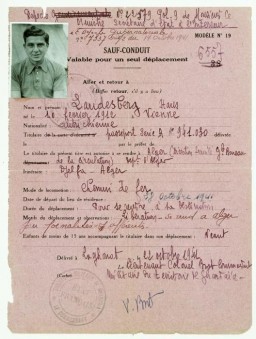
-
Yugoslav partisans prepare to fight
FilmAt his hidden headquarters in the mountains of Yugoslavia, Marshal Tito (Josip Broz), head of the Yugoslav Communist partisan movement, prepares his forces for battle. Women gather silk parachutes, used to drop supplies by Allied forces, for use as bandages. Partisans train, preparing to fight the Germans. At the height of the partisan war in Yugoslavia in 1943, Tito's partisans engaged some 35 Axis divisions, which otherwise might have been in service on the Italian or eastern fronts.

-
Warsaw Polish uprising
FilmOn August 1, 1944, the Armia Krajowa (Polish Home Army) launched an uprising in Warsaw against the German occupiers. Although the Western allies dropped ammunition and supplies and the Soviet army was within sight of the city, the uprising was crushed. This German newsreel footage shows the German suppression of the uprising.
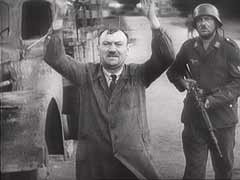
-
Buchenwald concentration camp
FilmClip from George Stevens' "The Nazi Concentration Camps." This German film footage was compiled as evidence and used by the prosecution at the Nuremberg trials.
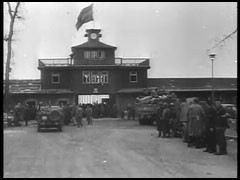
-
Doriane Kurz describes appell (roll call) in Bergen-Belsen
Oral HistoryDoriane's Jewish family fled to Amsterdam in 1940, the same year Germany occupied the Netherlands. Her father died after deportation to Auschwitz. After their mother was seized, Doriane and her brother hid with gentiles. The three were reunited at Bergen-Belsen, where they were deported via Westerbork. They were liberated during the camp's 1945 evacuation, when Doriane was 9. Her mother died of cancer soon after Doriane helped her recover from typhus. Doriane and her brother immigrated to the United States.
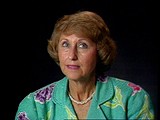
-
Fela Warschau describes the Feldafing displaced persons camp
Oral HistoryFela was liberated at Bergen-Belsen by the British army in 1945. She went to a displaced persons (DP) camp administered by the Americans in Feldafing, near Munich. She married in the DP camp in 1946, and eventually immigrated to the United States.
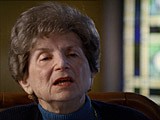
-
Rachel Mutterperl Goldfarb describes partisan attacks on Germans
Oral HistoryThe Germans established a ghetto in Dokszyce in late 1941. Rachel hid during the liquidation of the ghetto in 1942, and she and her mother escaped to another ghetto. When the second ghetto was about to be liquidated, they escaped again. Rachel and her mother joined a band of partisans in the forest. She helped her mother to cook, and also cleaned weapons. Rachel and her mother tried to leave Europe when the war ended. They eventually arrived in the United States, in 1947.

-
Ernest G. Heppner describes arrival in Shanghai
Oral HistoryErnest's family owned a factory that made matzah, the unleavened bread eaten during Passover. In February 1939, three months after Kristallnacht (the "Night of Broken Glass" pogroms), Ernest and his mother fled to Shanghai, one of few havens for refugees without visas. His father and sister stayed behind in Germany; they perished during the Holocaust. A brother escaped to England. Ernest and his mother found work in Shanghai. In 1947, he came to the United States with his wife, whom he met and married in…
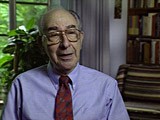
-
Hanne Hirsch Liebmann describes harassment and anti-Jewish sentiment in Germany
Oral HistoryHanne's family owned a photographic studio. In October 1940, she and other family members were deported to the Gurs camp in southern France. In September 1941, the Children's Aid Society (OSE) rescued Hanne and she hid in a children's home in Le Chambon-sur-Lignon. Her mother perished in Auschwitz. In 1943, Hanne obtained false papers and crossed into Switzerland. She married in Geneva in 1945 and had a daughter in 1946. In 1948, she arrived in the United States.
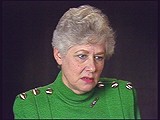
-
Harold Herbst describes meeting a prisoner on the verge of death (known as a "Muselmann") in Buchenwald
Oral HistoryAfter studying medicine at Wayne State University in Michigan, Harold joined the army in 1942. He was attached to the 107th Evacuation Hospital. The unit trained in Belfast, Northern Ireland, and then tracked the US First Army after the June 1944 Normandy invasion. Harold was attached to the US Third Army under George S. Patton in December. He went to Buchenwald shortly after the SS guards fled the camp in April 1945.

-
Alice Lok Cahana describes arrival at Bergen-Belsen
Oral HistoryGermany occupied Hungary in 1944. Alice was deported to Auschwitz in the same year. At one time she was selected for the gas chamber, but survived because of a malfunction. As Allied forces approached the camp, Alice and other inmates were evacuated to the Guben labor camp. Alice, her sister, and another girl escaped during a forced march from the camp but were found and sent on to Bergen-Belsen. Alice's sister was taken to a Red Cross hospital, but Alice never saw her again. After the war, Alice…
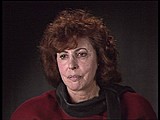
-
John Dolibois describes attitude of captured Nazi leaders
Oral HistoryJohn Dolibois immigrated to the United States in 1931 at the age of 13. After graduating from college, Dolibois joined the 16th Armored Division of the US Army. Due to his German language skills, he became involved in military intelligence. He returned to Europe in this capacity toward the end of World War II. Dolibois interrogated German prisoners of war, including leading Nazis, in preparation for the postwar trials of war criminals. He was later appointed US ambassador to Luxembourg, his birthplace.
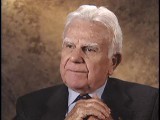
-
Drexel Sprecher describes a witness at the Nuremberg trials
Oral HistoryDrexel Sprecher was educated at the University of Wisconsin, the London School of Economics, and at the Harvard School of Law before receiving a position at the US Government's Labor Board in 1938. He enlisted in the American military after the United States declared war on Germany, and was posted to London. After the war, Sprecher served as a prosecutor of Nazi war criminals at the Nuremberg trials.
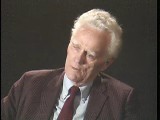
-
Drexel Sprecher describes layout of the courtroom at Nuremberg
Oral HistoryDrexel Sprecher was educated at the University of Wisconsin, the London School of Economics, and at the Harvard School of Law before receiving a position at the US Government's Labor Board in 1938. He enlisted in the American military after the United States declared war on Germany, and was posted to London. After the war, Sprecher served as a prosecutor of Nazi war criminals at the Nuremberg trials.

-
Historian Peter Black describes impact of the Braunsteiner Ryan case
Oral HistoryIn the 1980s and 1990s, historian Peter Black worked for the US Department of Justice Office of Special Investigations, as part of a team tracking and prosecuting suspected war criminals. Black later served as the Senior Historian at the United States Holocaust Memorial Museum.
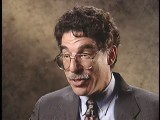
-
Historian Peter Black describes the importance of legal consequences
Oral HistoryIn the 1980s and 1990s, historian Peter Black worked for the US Department of Justice Office of Special Investigations, as part of a team tracking and prosecuting suspected war criminals. Black later served as the Senior Historian at the United States Holocaust Memorial Museum.
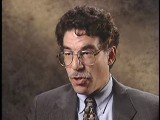
-
George Salton describes his physical condition upon liberation
Oral HistoryGeorge was liberated by the American forces in May 1945. He had spent three years during the war in ten different concentration camps. In 1945 he was in the Woebbelin camp in Germany. After liberation, he spent over two years in various displaced persons camps. George immigrated to the United States in October 1947.
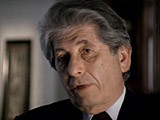
-
Ruth Meyerowitz describes her memories of the Auschwitz crematoria
Oral HistoryIn Frankfurt, Ruth's family faced intensifying anti-Jewish measures; her father's business was taken over and Ruth's Jewish school was closed. In April 1943, Ruth and her family were deported to Auschwitz. Ruth was selected for forced labor and assigned to work on road repairs. She also worked in the "Kanada" unit, sorting possessions brought into the camp. In November 1944, Ruth was transferred to the Ravensbrueck camp system, in Germany. She was liberated in May 1945, during a death march from the…
